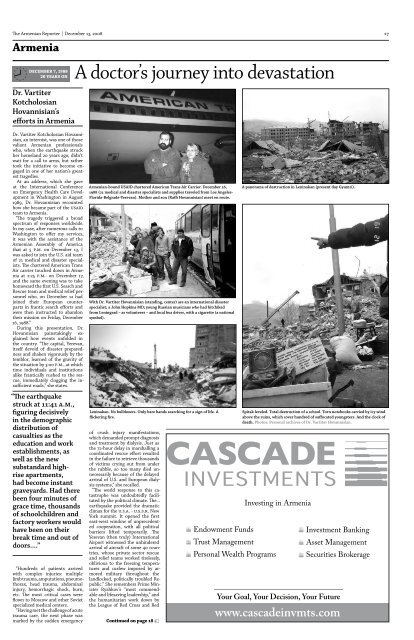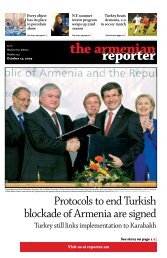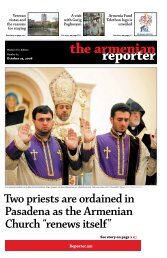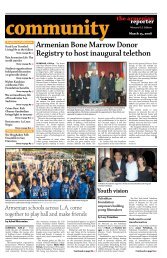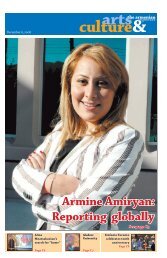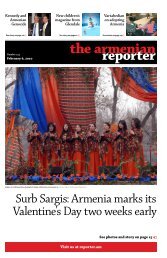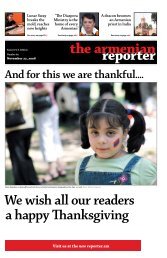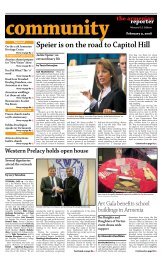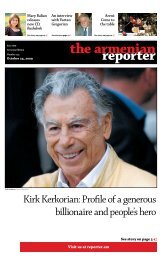16 The <strong>Armenia</strong>n Reporter | December 13, 2008<strong>Armenia</strong>December 7, 198820 years onThe inextinguishablepower of lifeby Armen HakobyanYEREVAN – Many are well acquaintedwith Marineh Nouroyanfrom the photograph in which sheis pictured with her three daughtersa few days after the 1988 Spitakearthquake. This photo, coinedthe “Madonna” or the “<strong>Armenia</strong>nMadonna,” became the witness <strong>and</strong>symbol of a nation’s tragedy <strong>and</strong> atthe same time the unbreakable willof the <strong>Armenia</strong>n people to survive<strong>and</strong> live after that horrifying disaster.Even today it seems as if theface of that <strong>Armenia</strong>n woman <strong>and</strong>her daughters staring at us fromthis 20-year-old picture says, “I callupon the living.” The expressionson their faces exude a combinationof terror, pain, <strong>and</strong> uncertainty; butabove all, they radiate the power oflife. Life, as it is.It is natural therefore, that in aphoto exhibition organized by theUrban Foundation for SustainableDevelopment (UFSD) <strong>and</strong> the U.S.Embassy a day before the 20th anniversaryof the earthquake, titledThe Path to Revival, in the foyer ofthe Moscow Cinema, this famousphotograph of Marineh Nouroyan<strong>and</strong> her three daughters togetherwith another, not-so-famous photograph,20 years later with hergr<strong>and</strong>children, was chosen as thefocal point of the exhibition <strong>and</strong>was also the cover image used onthe exhibition booklet.“At that time I was at home,” Mrs.Nouroyan said during the openingceremony of the exhibition, recountingthe dreadful moments of1988. Her speech was brief but atthe same time very moving. “Whenit shook, I took the children <strong>and</strong>ran toward the door. We reachedthe door, but the ground slippedfrom under out feet <strong>and</strong> we fellDecember 7, 198820 years onThe <strong>Armenia</strong>n Madonna lives onMkhitar Khachatrian <strong>and</strong> Marineh Nouroyan. Photo: Armen Hakobyan for the<strong>Armenia</strong>n Reporter.down. Then it shook again <strong>and</strong> weonce again went down. Then somefresh air came in <strong>and</strong> we startedbreathing. The rescue group ofthe Nairit Factory pulled us out ofthe ruins on the second night.” Atthat time Mrs. Nouroyan’s familylived on the 5th floor of Hertzen1/1 building. The building was completelydestroyed.Marineh falls silent. Her emotionspeak <strong>and</strong> through her eyes she reachesthe hearts of each <strong>and</strong> every onein the foyer. I spoke with Marineh’shusb<strong>and</strong>, Saro Mirzakhanian. “Itwas a disaster. What should I tellyou?” he sighs heavily <strong>and</strong> only thendoes he realize that I have askedhim to talk about himself <strong>and</strong> hisfamily’s present life <strong>and</strong> not the disaster.About life. Saro is a carpenter<strong>and</strong> makes doors <strong>and</strong> windows.During the past several years he hasbeen able to care for the needs ofhis family by working abroad, butthe last time he went to work thereit was not good. In his home cityof Gyumri, Saro tries to resolve thefinancial issues of his family by takingoccasional orders. He is only 51years old <strong>and</strong> knows his craft well.I want to believe that there will beemployment for him in the promisedreconstruction works.The family has grown during thepast 20 years. Marineh <strong>and</strong> Saroproudly say, “We have four children:Anna (28 years old), Christine(26), Shushanik (21) <strong>and</strong> David(13). Our David was born after theearthquake.” If we bear in mindthat, as a result of the earthquake,Marineh’s health was affected (theboard of doctors evaluated her conditionas a second degree disability),then the birth of the fourthchild David is indeed heroism onher part. Marineh with her kindsmile <strong>and</strong> with the pride of an experiencedgr<strong>and</strong>mother adds, “Ihave four gr<strong>and</strong>children: two boys<strong>and</strong> two girls: Samvel <strong>and</strong> Arman,Suzanna <strong>and</strong> Marineh.” Their threedaughters have given their parentsthe joy of being gr<strong>and</strong>parents.I ask them how they survive.“Wedo it just like the others. I have acraft, if there is an order I work.Work is intermittent, not stable.Marineh receives second degreedisability benefits <strong>and</strong> we receivea family allowance,” Saro says.Marineh Nouroyan adds, “I live formy children. Life is monotonous.You know, life in Gyumri seems tohave stopped; there are no jobs <strong>and</strong>the menfolk go abroad to work. Itis very hard. We live in the Austri<strong>and</strong>istrict. I receive a benefit for myillness. My husb<strong>and</strong> was abroad;his work did not go so well, so hehas returned. He strives <strong>and</strong> worriestrying to achieve something.Let’s see what happens.”Photojournalist Mkhitar Khachatrian,our colleague from thePhotolure Agency in <strong>Armenia</strong>, thephotographer of that picture, isalso at the exhibition. I ask him torecount how he captured that photo,which became a unique symbolof survival after the 1988 disaster.“Misha Kalantar <strong>and</strong> I wereat the airport,” recounts Mkhitar.“Suddenly one of the journalists ofthe Russian-language Communistnewspaper told me about a woman<strong>and</strong> her three daughters who hadbeen saved after they had spent aday under the ruins <strong>and</strong> gave methe address. However, to be honestwith you, I did not particularly wantto go. There was so much chaos atthe time, even the addresses hadconditional meanings. Those whohad been saved wrote on the ruins,‘We are in such <strong>and</strong> such a place, donot keep searching for us…’“Finally we went <strong>and</strong> foundMarineh, who had found shelter inher mother’s home. We knockedon the door <strong>and</strong> her daughteropened it. I took a picture of herright there, like that. I told them‘Children hold on tight to yourmother,’ <strong>and</strong> I took the picture.We named this picture the Madonna.Even that has an interestingstory. The picture was printedon the front page of the Russianlanguagedaily Izvestia publishedin Moscow <strong>and</strong> one of the readers,a Russian woman inspired bythe photograph, wrote a touchingpoem entitled “The Madonna ofthe 20th Century.” My Russiancolleagues sent me that poem <strong>and</strong>that is how we named the picture,the Madonna,” he tells us.Mkhitar falls silent too. A littlebit later, he notes, “Wheneverpeople from our generation talkabout the earthquake, their mindstays all day on the earthquake<strong>and</strong> they can only think aboutthat. Probably there is an explanationfor that. Twenty years havepassed <strong>and</strong> many of the youngpeople are aware of it only becausethey have heard about it,but have not seen it. God forbidthat they ever see it. Anyway, thesubject changes <strong>and</strong> life moveson. Yes, I still visit the same sitesof the disaster. Of course, thereare many changes. We are movingforward, but slowly. However,there should not have been anyruins left there after 20 years, butif you visit today you can still photographthem.” Nevertheless, asMkhitar says “the subject changes.”Life moves on; it moves on withthe power of survival of peoplelike Marineh <strong>and</strong> thous<strong>and</strong>s <strong>and</strong>thous<strong>and</strong>s of people like her. f<strong>Armenia</strong> will never forget the support of the United Statesby Armen HakobyanYEREVAN – The photo exhibitiontitled, The Path to Revival, whichopened on December 5, a day beforethe 20th anniversary of the1988 Spitak earthquake, emphasizedsomething truly significant.It reflected the compassionate responseto <strong>Armenia</strong>’s loss <strong>and</strong> pain.Together with the United States,more than 70 other countries cameto <strong>Armenia</strong>’s aid. At the same timethe photos on exhibit told the storyof how the United States <strong>and</strong> itshumanitarian organizations <strong>and</strong>the American-<strong>Armenia</strong>n communitycame together during the days<strong>and</strong> weeks following the tragedy.As Marie Yovanovich, the U.S.ambassador to <strong>Armenia</strong>, noted atthe opening ceremonies, duringthe period of immediate responseto the disaster, <strong>and</strong> also during thefollowing years, the U.S. government<strong>and</strong> several volunteer agenciesallocated about $51 million ofaid to <strong>Armenia</strong>. This aid was distributedvia several projects. AfterWorld War II, the 1988 earthquakewas the first time the USSR acceptedhelp from the U.S. In essence,apart from the material factor, thecore value of the aid was importantboth as the manifestation of thegoodwill of the American state <strong>and</strong>goodwill on a humanitarian <strong>and</strong>personal level.As far as recent U.S. supportis concerned, USAID projects implementedin the disaster zonewithin the framework of the Certificatesfor Apartment Purchase(CAP) from 2000 to 2004 were amajor contribution. Steve Anlian,who was head of the projectat the time, said that the entireproject was worth about $35 million.Through the implementationof that program about 7,000families who had been left homeless<strong>and</strong> were living in temporaryshelters or shacks received apartments.In addition, numerous districtsof temporary shacks werecleared away as their former residentshad acquired apartmentsthrough the U.S.-funded project.The mechanism of the project wasvery simple: after doing the researchanalysis, certificates guaranteeing acertain sum were given to those residentsin need. The residents thenwere able to purchase apartmentswith those certificates (if they wereable, they could add their own moneyto the sum). Within the frameworkof this project, it is envisagedthat in 2009 another 480 familieswill receive apartment purchasecertificates. The <strong>Armenia</strong>n governmentadopted the mechanism ofapartment purchase certificates <strong>and</strong>uses it when implementing projectsaimed at securing the housing needsof other social groups.Felix Pirumian, PresidentSerge Sargsian’s consultant, whowas the minister of city constructionfrom 1993 to 1999 <strong>and</strong> theShirak governor during the implementationof the CAP project,spoke with the <strong>Armenia</strong>n Reporterduring the opening of the photoexhibit. “If we view the pictureof the disaster zone objectively,during the past 20 years <strong>and</strong> thelast 10 years, then we will see thatduring the first period, the entireworld, about 75 states, helped <strong>and</strong>there was also the Soviet Unionwith its immense potential. However,after the collapse of the USSR,U.S. AmbassadorMarieYovanovichlooking at thephotos fromthe earthquake.Photo: ArmenHakobyan forthe <strong>Armenia</strong>nReporter.when the construction teams ofother countries left <strong>Armenia</strong>, wewere left alone with our problem.At that time, <strong>Armenia</strong> had no financialmeans to solve the issueof restoring the disaster zone,” Mr.Pirumian said.He said that when RobertKocharian became the primeminister in 1997, the issue of reassessingthe situation in orderto underst<strong>and</strong> the state’s responsibilities<strong>and</strong> prepare a programwas put into motion. The preparationof the project took a verylong time, as implementing a censusof a poor population in thecommunities was very difficult,especially when the situation inGyumri was so dire that no datahad been preserved. “The programswere carried out, nevertheless,<strong>and</strong> we managed to set thesolution of the issue on a course,which dem<strong>and</strong>ed huge financialresources,” he said.It was during this time periodthat USAID implemented the Certificatefor Apartment Purchaseproject <strong>and</strong> extended a h<strong>and</strong>to <strong>Armenia</strong>. This endeavor wasmatched by the Lincy Foundation,<strong>Armenia</strong>’s state budget, <strong>and</strong>the support of other benefactors.“However, they took the first big<strong>and</strong> essential step. It was a greathelp. At that time we were solvingissues only through capital investmentsaimed at apartment construction.In other words, havinglimited resources we were solvingthe issue by the most expensivemethods <strong>and</strong> we were not usingavailable resources. Many thoughtthat it would not be a big deal <strong>and</strong>the numbers of those receivingcompensation would not exceed1,000. However, the number ofthose families in Gyumri exceeded3,500. And today the CAP projectcontinues; it was one of the bestmethods for the solution of the issue,”Mr. Pirumian said. f
The <strong>Armenia</strong>n Reporter | December 13, 2008 17<strong>Armenia</strong>December 7, 198820 years onA doctor’s journey into devastationDr. VartiterKotcholosianHovannisian’sefforts in <strong>Armenia</strong>Dr. Vartiter Kotcholosian Hovannisian,an internist, was one of thosevaliant <strong>Armenia</strong>n professionalswho, when the earthquake struckher homel<strong>and</strong> 20 years ago, didn’twait for a call to arms, but rathertook the initiative to become engagedin one of her nation’s greatesttragedies.At an address, which she gaveat the <strong>International</strong> Conferenceon Emergency Health Care Developmentin Washington in August1989, Dr. Hovannisian recountedhow she became part of the USAIDteam to <strong>Armenia</strong>.“The tragedy triggered a broadspectrum of responses worldwide.In my case, after numerous calls toWashington to offer my services,it was with the assistance of the<strong>Armenia</strong>n Assembly of Americathat at 5 P.M. on December 13, Iwas asked to join the U.S. aid teamof 21 medical <strong>and</strong> disaster specialists.The chartered American TransAir carrier touched down in <strong>Armenia</strong>at 2:25 P.M.. on December 17,<strong>and</strong> the same evening was to takehomeward the first U.S. Search <strong>and</strong>Rescue team <strong>and</strong> medical relief personnelwho, on December 12 hadjoined their European counterpartsin frantic search efforts <strong>and</strong>were then instructed to ab<strong>and</strong>ontheir mission on Friday, December16, 1988.”During this presentation, Dr.Hovannisian painstakingly explainedhow events unfolded inthe country. “The capital, Yerevan,itself devoid of disaster preparedness<strong>and</strong> shaken vigorously by thetemblor, learned of the gravity ofthe situation by 3:00 P.M., at whichtime individuals <strong>and</strong> institutionsalike frantically rushed to the rescue,immediately clogging the insufficientroads,” she states.“The earthquakestruck at 11:41 A.M.,figuring decisivelyin the demographicdistribution ofcasualties as theeducation <strong>and</strong> workestablishments, aswell as the newsubst<strong>and</strong>ard highriseapartments,had become instantgraveyards. Had therebeen four minutes ofgrace time, thous<strong>and</strong>sof schoolchildren <strong>and</strong>factory workers wouldhave been on theirbreak time <strong>and</strong> out ofdoors....”“Hundreds of patients arrivedwith complex injuries: multiplelimb trauma, amputations, pneumothorax,head trauma, abdominalinjury, hemorrhagic shock, burn,etc. The most critical cases wereflown to Moscow <strong>and</strong> other Sovietspecialized medical centers.“Having met the challenge of acutetrauma care, the next phase wasmarked by the sudden emergency<strong>Armenia</strong>n-bound USAID chartered American Trans Air Carrier. December 16,1988 (21 medical <strong>and</strong> disaster specialists <strong>and</strong> supplies traveled from Los Angeles-Florida-Belgrade-Yerevan). Mother <strong>and</strong> son (Raffi Hovannisian) meet en route.With Dr. Vartiter Hovannisian (st<strong>and</strong>ing, center) are an international disasterspecialist; a John Hopkins MD; young Russian musicians who had hitchikedfrom Leningrad – as volunteers – <strong>and</strong> local bus driver, with a cigarette (a nationalsymbol).Leninakan. No bulldozers. Only bare h<strong>and</strong>s searching for a sign of life. Aflickering fire.of crush injury manifestations,which dem<strong>and</strong>ed prompt diagnosis<strong>and</strong> treatment by dialysis. Just asthe 72-hour delay in marshalling acoordinated rescue effort resultedin the failure to retrieve thous<strong>and</strong>sof victims crying out from underthe rubble, so too many died unnecessarilybecause of the delayedarrival of U.S. <strong>and</strong> European dialysissystems,” she recalled.“The world response to this catastrophewas undoubtedly facilitatedby the political climate. The...earthquake provided the dramaticclimax for the U.S.A. - U.S.S.R. NewYork summit. It opened the firsteast-west window of unprecedentedcooperation, with all politicalbarriers lifted temporarily. TheYerevan (then truly) <strong>International</strong>Airport witnessed the unhinderedarrival of aircraft of some 40 countries,whose private sector rescue<strong>and</strong> relief teams worked tirelessly,oblivious to the freezing temperatures<strong>and</strong> curfew imposed by armoredmilitary throughout thel<strong>and</strong>locked, politically troubled Republic.”She remembers Prime MinisterRyzhkov’s “most commendable<strong>and</strong> lifesaving leadership,” <strong>and</strong>the humanitarian work down bythe League of Red Cross <strong>and</strong> RedContinued on page 18 mA panorama of destruction in Leninakan (present day Gyumri).Spitak leveled. Total destruction of a school. Torn notebooks carried by icy windabove the ruins, which cover hundred of suffocated youngsters. And the clock ofdeath. Photos: Personal archives of Dr. Vartiter Hovannisian.


